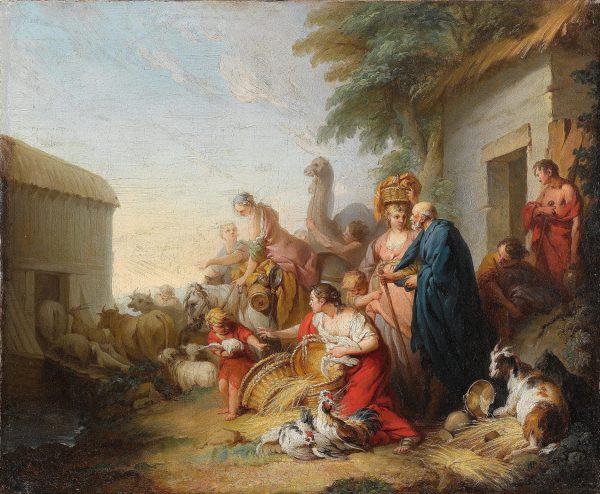Noah Entering the Ark, ca. 1720-1727.
Oil on canvas, H. 0.5 m; W. 0.61 m
Provenance: Sold Versailles, 18 November 1962, no. 32.
Private collection.
A. Ananoff and D. Wildenstein, L’opera completa di Boucher, Milan, 1980, no. 29.
With his vision of a happy world, François Boucher is the most representative painter of 18th century France. He had a brilliant career and received all the honours possible. A pupil of François Lemoyne, he completely renewed history painting which, with unequalled refinement, now echoed the elegance of Parisian society. A great decorator, he was involved with the main commissions for the royal residences and also worked for townhouses, created sets for the Opera and designed tapestry cartoons.
During the 1720s and 30s Boucher devoted his time almost exclusively to depicting scenes from the Old Testament. He chose moving biblical stories and placed them into narrative compositions, ‘imparting dignity of gesture and emotional expressiveness to the figures on the canvas.’ (M.Hyde, Rethinking Boucher, Los Angeles, 2006, p.63.) Contemporary French historical painters including his master Francois Lemoyne, played a key role in shaping Boucher’s artistic language particularly in his religious scenes but perhaps more influential were the artists of the Italian Baroque (particularly those from Genoa, Bologna and Venice). Though he had exposure to the Italian manner through his artistic training, his stay in Rome impacted him further. Boucher received the First Price of the French royal Academy and was a pensionnaire at the Académie de France in Rome from 1727 to 1731. There he became immersed in the art in churches and major collections.
This painting entitled Noah entering the Ark is a beautiful example of Boucher’s early interest in biblical scenes. Boucher characteristically renders his figures in a way that makes them appear human. All the figures are in mid-movement. In fact, not a single figure is seen perfectly from the front. What is typical of Boucher is that in his compositions more space and significance is usually assigned to the female figures than to the male ones as is seen here (with the exception of the protagonist, Noah).
What defined Boucher’s biblical paintings compared to those of his predecessors was a ‘relaxation of traditional austerity’ through the humanizing of the sacred.(M.Hyde, Rethinking Boucher, Los Angeles, 2006, p.75.) Whether this was purely for aesthetic reasons, or as a means of reflecting religious attitudes that were becoming more widespread in mid-eighteenth-century French society, is debatable. Religion at the time became centered on the notion of the vie unique, a way of life that incorporated Christian principles in a less rigid way. Thus, there is a distinct interaction between the spiritual and earthy with biblical characters becoming more human in their gestures and poses. Just as Boucher had given the protagonists of his mythological scenes human qualities in order to eliminate the feeling of an idealized sublime, so he did with his religious subjects.
This painting is related to Boucher’s version of the same theme that had long been considered lost before it was rediscovered in the 1980s (see Laing, 1986, no. 10, illustrated). This other variant of Noah Entering the Ark together with Noah’s Sacrifice formed a prominent pair in the Jullienne collection.
The present painting is larger than the Forth Worth version, with its format approximating a square. It is likely that a patron had seen the first pendants in Boucher’s workshop and ordered a replica in a more classical format. Therefore, Boucher shortened the area of the sky and brought the building on the right-hand side and the ark on the left closer together.
Scholars generally agree now that these paintings date from the period before Boucher left for Rome and could have been produced as a gift for the original owner whose financial support over four or five years enabled the artist’s trip. The early dating was initially dismissed because of the clear link to Castiglione’s compositions that obviously implied the artist’s exposure to the art of Italy. Similarly, the level of detail given to the animals and the gleaming copper basins hinted at Boucher’s Dutch-inspired works produced after his return.
Nonetheless, there appears to be no link between Castiglione and Boucher’s palettes or brushwork. Thus, Castiglione’s influence is only thematic. The fact that Boucher decided to imitate the content rather than the style of Castiglione’s paintings in this work, suggests he was inspired mostly by engravings that would have been available in France; it was only once he had been to Italy that his full appreciation of Castiglione gained momentum and he embraced both the colours and brushstrokes of the artist.
The handling of the paint in Noah Entering the Ark is different to that of the works produced after his return from Italy and is far more similar to earlier canvases including Mucius Scaevola. The small liquid brushstrokes and the vivid saturated hues stand as testimony of this view. Equally, the creases in the drapery hark back to some of the mannerisms of Mucius Scaevola, as do the faces and windswept locks of the figures that inhabit the scene.
For details such as the cockerel and the hens, Boucher used his preliminary studies for his Fontaine in the National Museum of Fine Arts in Stockholm (see P. Bjurström, French Drawings Eighteenth Century, Stockholm 1982, figs. 823 and 824).
Looking at the perspective diagonals in Noah Entering the Ark one can see that the ‘vertiginous exaggeration [is] characteristic of a group of Boucher’s early pastoral landscapes, and the trees and foliage are imbued with the sinuous, bushy vitality also found in those youthful works.’ (A. Laing, François Boucher, 1703-1770, The Metropolitan Museum of Art, New York, 1986, p.115.) This painting therefore, is particularly important for illustrating Boucher’s early style whilst giving clear foresight into his later artistic endeavors.


